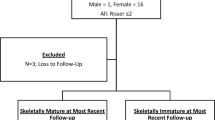Abstract
Purpose
Durability of outcomes following vertebral body tethering (VBT) is a concern and may be impacted by tether breakage (TB), which has been unstudied in a large cohort. We characterized TB rates and their impact on clinical outcomes in the largest single-surgeon series to date.
Methods
Inclusion criteria were VBT patients with AIS, major Cobb angle ≤ 75°, and minimum 2-year follow-up (FU). TBs were identified on 1- and 2-year FU X-rays. TB rates between single-cord and double-cord tethers were evaluated using two-proportion z test. Curve correction rates and SRS-22 scores between patients with and without TB at 2 years were evaluated using Mann–Whitney U test.
Results
69 patients were included. By 2-year FU, 18 (27%) had experienced TB. TB primarily occurred in major (70%) versus minor curves and thoracolumbar tethers (75%) versus thoracic. TB rates between thoracolumbar single (32%) and double-cord tethers (30%) were not significantly different (p = 0.88). Mean major curve correction at 2-year FU was lower (p = 0.02) in patients with major curve TB (48° to 24°, 50%) versus those without (53°–21°, 60%). 2 patients (3%) required reoperation, 1 due to foraminal encroachment from a screw tip and 1 for curve progression with TB.
Conclusion
TB rate was 27% at 2 years following VBT. Broken major curve tethers are associated with minor loss of correction that may not be clinically significant. TB rates are higher for thoracolumbar curvatures and double cords may not be protective against TB. Further study of long-term TB rates is imperative.
Level of evidence
IV


Similar content being viewed by others
References
Murphy RF, Mooney JF (2017) The Crankshaft phenomenon. J Am Acad Orthop Surg 25(9):e185–e193. https://doi.org/10.5435/JAAOS-D-16-00584
Pehlivanoglu T, Oltulu I, Erdag Y et al (2021) Comparison of clinical and functional outcomes of vertebral body tethering to posterior spinal fusion in patients with adolescent idiopathic scoliosis and evaluation of quality of life: preliminary results. Spine Deform. https://doi.org/10.1007/s43390-021-00323-5 (published ahead of print)
Newton PO, Kluck DG, Saito W et al (2018) Anterior spinal growth tethering for skeletally immature patients with scoliosis: a retrospective look two to four years postoperatively. J Bone Jt Surg Am 100(19):1691–1697. https://doi.org/10.2106/JBJS.18.00287
Hoernschemeyer DG, Boeyer ME, Robertson ME et al (2020) Anterior vertebral body tethering for adolescent scoliosis with growth remaining: a retrospective review of 2 to 5-year postoperative results. J Bone Jt Surg Am 102(13):1169–1176. https://doi.org/10.2106/JBJS.19.00980
Baker CE, Kiebzak GM, Neal KM (2021) Anterior vertebral body tethering shows mixed results at 2-year follow-up. Spine Deform 9(2):481–489. https://doi.org/10.1007/s43390-020-00226-x
Miyanji F, Pawelek J, Nasto LA et al (2020) Safety and efficacy of anterior vertebral body tethering in the treatment of idiopathic scoliosis. Bone Jt J 102-B(12):1703–1708. https://doi.org/10.1302/0301-620X.102B12.BJJ-2020-0426
Fabricant PD, Admoni S, Green DW et al (2012) Return to athletic activity after posterior spinal fusion for adolescent idiopathic scoliosis analysis of independent predictors. J Pediatr Orthop 32(3):259–265
Lonner BS, Ren Y, Upasani VV et al (2018) Disc degeneration in unfused caudal motion segments ten years following surgery for adolescent idiopathic scoliosis. Spine Deform 6(6):684–690
Baroncini A, Trobisch PD, Migliorini F (2021) Learning curve for vertebral body tethering: analysis on 90 consecutive patients. Spine Deform 9(1):141–147. https://doi.org/10.1007/s43390-020-00191-5
Baker CE, Milbrandt TA, Larson AN (2021) Anterior vertebral body tethering for adolescent idiopathic scoliosis: early results and future directions. Orthop Clin N Am 52(2):137–147. https://doi.org/10.1016/j.ocl.2021.01.003
Alanay A, Yucekul A, Abul K et al (2020) Thoracoscopic vertebral body tethering for adolescent idiopathic scoliosis: follow-up curve behavior according to sanders skeletal maturity staging. Spine (Phila Pa 1976) 45(22):E1483–E1492. https://doi.org/10.1097/BRS.0000000000003643
Qiu C, Talwar D, Gordon J et al (2021) Patient-reported outcomes are equivalent in patients who receive vertebral body tethering versus posterior spinal fusion in adolescent idiopathic scoliosis. Orthopedics 44(1):24–28. https://doi.org/10.3928/01477447-20201119-02
Trobisch PD, Baroncini A (2021) Preliminary outcomes after vertebral body tethering (VBT) for lumbar curves and subanalysis of a 1-verrsus 2-tether construct. Eur Spine J 30:3570–3576
Funding
No funding was received for this work.
Author information
Authors and Affiliations
Corresponding author
Ethics declarations
Conflict of interest
Dr. Lonner reports personal fees and royalty fees from Zimmer Biomet for The Tether implant. Dr. Lonner also reports personal fees, non-financial support and other from Depuy Synthes, personal fees and non-financial support from OrthoPediatrics, stocks/stock options from Spine Search, grants and other from Setting Scoliosis Straight Foundation, outside the submitted work. The remaining authors have no disclosures to report.
Ethical approval
This work was approved by the Institutional Review Board at Mount Sinai Hospital.
Consent to participate
This work was performed under a waiver of informed consent approved by the Institutional Review Board at Mount Sinai Hospital.
Consent for publication
Not applicable.
Availability of data
Data will be maintained for this study for up to 7 years post-publication as required by our institution’s review board.
Code availability
Not applicable.
Additional information
Publisher's Note
Springer Nature remains neutral with regard to jurisdictional claims in published maps and institutional affiliations.
Rights and permissions
About this article
Cite this article
Shankar, D., Eaker, L., von Treuheim, T.P. et al. Anterior vertebral body tethering for idiopathic scoliosis: how well does the tether hold up?. Spine Deform 10, 799–809 (2022). https://doi.org/10.1007/s43390-022-00490-z
Received:
Accepted:
Published:
Issue Date:
DOI: https://doi.org/10.1007/s43390-022-00490-z




